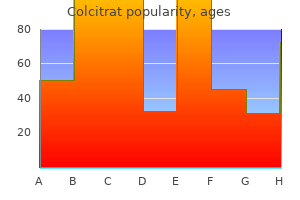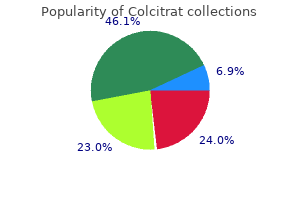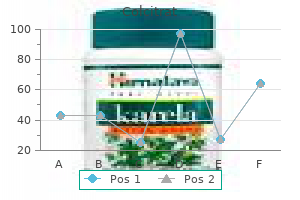

 5100 Springfield St. Suite 108, Dayton, Ohio 45431-1274
5100 Springfield St. Suite 108, Dayton, Ohio 45431-1274Colcitrat
"Order colcitrat 0.5 mg mastercard, treatment for sinus infection in toddlers".
By: Z. Mazin, M.A., M.D., M.P.H.
Clinical Director, Saint Louis University School of Medicine
Validated against dementia and other psychiatric groups it has anchored ratings for its 16 items (Trzepacz et al infection with normal wbc purchase 0.5 mg colcitrat with amex. The degree of mechanical shearing caused by acceleration/deceleration forces may determine the depth of lesion along a continuum from the surface of the cortex to the brain stem (Ommaya and Gennarelli 1974) antibiotic resistance argument order colcitrat 0.5 mg amex. The severity of impaired consciousness did not differ among lesions located in frontal and temporal lobes antibiotics in copd exacerbation discount 0.5mg colcitrat with amex, however (Levin et al. Brain regions involved in maintaining consciousness probably involve the cerebral cortex, tertiary association cortices, default brain network nodes and thalamus. When these are impaired delirium can occur, but when deeper regions including brainstem reticular activating system and thalamus are involved, there is a higher likelihood of unconsciousness (unarousal). Residual medical, cognitive, behavioral, linguistic, and psychosocial problems all may impede recovery to premorbid levels (Levin 1995). However, they excluded patients with important and common delirium risk factors from their study, including prior neurological events, psychiatric problems, developmental disability, and drug/alcohol dependency. Psychotic-like symptoms at 21 days were particularly predictive of occupational dysfunction. Neuropathophysiology of Delirium in Traumatic Brain Injury Delirium is considered to be a syndrome in which a characteristic constellation of signs and symptoms can result from a variety of different causes. It has been hypothesized that the pathophysiological mechanisms of different etiologies affect the brain in such a way that they converge into a final common neural pathway that produces the syndrome (Trzepacz et al. This proposed final common neural pathway involves a network of regions and circuits. The ultimate precipitating neuropathophysiologies probably involve oxidative metabolism, intracellular cytoarchitecture and protein changes, cytokine and other inflammatory-related activity, synaptic dysfunction, and neurotransmitter activity alterations that give rise to the characteristic symptoms. Three types of brain injury can each result in delirium (confusion), which commonly occurs following emergence from coma or minimal conscious state. Diffuse axonal injury alone or in combination with focal injuries can lead to delirium; when these are combined with hypoxic/ischemic damage, the resultant delirium can be especially prolonged. Focal injury presents with confusion depending on its location and whether it is accompanied by inflammation and edema. Most of these brain regions also play a role in various components of attention and higher-level information processing. The thalamus plays a key role in sensorimotor gating and attention and is reciprocally interconnected with all cortical regions. In animals, increased systemic aminergic activity and increased dopaminergic tone in the nucleus accumbens cause sensorimotor gating failure and administration of haloperidol, a dopamine-2 (D2) blocker, attenuates this effect (Mansbach et al. Animal models of sensorimotor gating impairment using prepulse inhibition report improvement using either dopamine receptor D2 blockers or muscarinic M1/ M4 agonists (Jones et al. The thalamus is poised at the intersection of the reticular activating system and circuitry to the cerebral cortex. Its interlaminar nuclei, which are highly cholinergic, are involved in sensorimotor gating and support cerebral cortical activation, along with the medial reticular activating system, and are important in subserving consciousness (Perry et al. Numerous alterations of brain function and structure, especially at the cellular level, occur immediately at the time of brain injury. The severity of these alterations depends on whether the injury is mild, moderate, or severe. Within hours to days these changes evolve and also induce consequences that impair the normal electrochemical and neural network functioning of the brain. Cholinergic neurons are particularly vulnerable to acute trauma-mediated dysfunction (Arciniegas 2003). Amnestic or other more circumscribed cognitive disorders occur/persist after the delirium clears when cholinergic activity is still suppressed but less so than during the delirium phase. Medications to treat posttraumatic delirium may need to have different characteristics from those to treat postdelirium cognitive problems, on the basis of an evolving neurochemical and clinical picture that includes severe damage to neuronal microstructure.
The only body region with a higher proportion of wounds in these wars was the extremities antibiotics gram positive cocci cheap colcitrat 0.5mg without a prescription, which accounted for 53% to 55% of injuries (Carey 1987) antibiotic resistance prediction purchase colcitrat in united states online. This assessment captures those with concussion who may have postponed evaluation or treatment during deployment and therefore were not identified by reviewing medical databases antibiotic resistance threats cdc generic 0.5 mg colcitrat amex. Fifty-six percent of these injuries were moderate to severe (including penetrating), and 44% were mild (Warden et al. Did any of the following problems begin or get worse after the event(s) you noted in question 9. As soon as the mission allows, the injured are evacuated from the battlefield to higher levels of care. In the event that more intensive evaluation or treatment is necessary, evacuation to higher echelons occurs. This evacuation does not always occur in a linear fashion but rather to the facility that allows safe and rapid transport. There is limited inpatient bed space, and therefore, holding times are limited to 72 hours. These facilities are highly mobile and may relocate on the basis of operational needs. Imaging techniques allow for reconstructions that can aid in forensic evaluation and ballistic trajectories, helping to ensure that no injuries are missed. Patients with less severe injury may be sent if prolonged recuperation is expected. Those patients requiring ongoing care are subsequently transferred stateside to a Level V facility. The National Naval Medical Center in Bethesda is the designated center for all penetrating injuries. While en route to the United States, complex critical care is provided by skilled critical care nurses and physicians. Altitude-approved monitors, ventilators, and other necessary medical devices are routinely used. Studies estimate that the rate blasts result in brain injuries is approximately 60% (Galarneau et al. Primary blast injury to the brain is hypothesized to result from direct exposure to overpressure or negative pressure waves that follow an explosion (Mayorga 1997). However, there is mounting evidence that primary blast injury affects organs with fluid interfaces that allow transfer of kinetic energy. It is hypothesized that this likely results in diffuse axonal injury in the brain and spinal cord. Secondary blast injury results when the explosive force energizes surrounding objects, setting them in motion. This injury pattern is typically seen in the neck and extremities because these areas are not completely covered by body armor. Tertiary injury results when kinetic injury from the explosion causes a person to be thrown into a stationary object. Burns and inhalation of gases or other toxic substances produce the fourth category of blast injury, quaternary injury.

Miles 1892) recognized that the injurious effects of stretching brain tissue were central to understanding the mechanisms of injury 1d infection tumblr colcitrat 0.5 mg without a prescription. In the latter half of the twentieth century bacteria growth temperature proven 0.5 mg colcitrat, the concepts of diffuse axonal injury and diffuse brain injury became the focus of research and clinical understanding bacteria in urinalysis cost of colcitrat, emphasizing the effects of trauma on the axon (Maruichi et al. The normal functioning of the brain depends on the connectivity of disparate brain regions automatically and synchronously integrating information and function (Kumar and Cook 2002). The technical assistance of Tracy Abildskov and Jo Ann Petrie for manuscript preparation is also gratefully acknowledged. The left panel demonstrates the relative density of vessels in the visual cortex of monkeys. The dense vascular mesh is displayed by perfusing the tissue with barium sulfate and imaging it with synchrotron-based X-ray microtomography (courtesy B. Although the density of the vessels appears to be high in this 3-D representation, it is actually less than 3% (see section at the right; white spots are cross-sections of vessels). This is approximately the distance that oxygen molecules travel by diffusion within the limited transit time of the blood. The dense population of neurons, synapses, and glia occupy the intervascular space, as depicted in the drawing at the top right-a hypothetical distribution of vascular and neural elements in a small section (red rectangle). As shown in the left panel, this is approximately the gross resolution of magnetic resonance imaging. Major brain landmarks can still be identified, which in this view include the cingulated gyrus (A), corpus callosum (B), and fornix (C). This image is from a normal adult control subject; note the fullness of the projecting tracts. In this section these neuroimaging procedures and others are more fully discussed. Details on the basis of structural imaging can be found in the first edition of Silver et al. Likewise, mechanical deformation, particularly around bony ridges and protuberances at the base of the skull, results in brain surface contusions (see Bigler 2007). The extent and locale of these hemorrhagic lesions become important for acute medical decision making in the management of the patient and likewise assist in making outcome predictions. These studies indicate that patients who meet medical criteria for severe injury. Although the worst outcome is associated with these types of abnormalities in combination, it should be obvious to the clinician that any of these abnormalities being singularly present carries with it some morbidity with regard to outcome. Even though there is effacement of the ventricle because of trauma-induced intracranial edema, the ventricle can be used to estimate original pretrauma size and used to track changes over time. As such, inferences have to be made about the underlying pathology that may be visualized as an abnormality in neuroimaging.

This test is not highly specific and may signify synovitis antibiotics for sinus infection in dogs buy generic colcitrat 0.5 mg line, an occult ganglia antibiotic amoxicillin 0.5mg colcitrat sale, or radioscaphoid impingement antibiotics for treating sinus infection discount colcitrat 0.5 mg line. Decreased space between the radius and the scaphoid signifies cartilage loss and arthrosis. Cineradiography reveals abnormal movements between the scaphoid and lunate and an increase in the scapholunate gap as the wrist moves from radial to ulnar deviation. Arthrography is not sp&ific and may be positive in conditions such as degenerative perforations of the scapholunate membrane and osteochondral de. Minor, degenerative perforation of the scapholunate membrane may result in a positive test. Scapholunate ligaments can be seen dearly only on transverse cuts that pass through the two horns of the lunate. It is useful in looking for other osseous anomalies of the wrist (eg, impacted fracture of the radius, scaphoid fracture). It allows grading of the instability (Geissler classification) and therefore determination of the degree of injury to the ligament complex. Table 1 Grade 1 2 Arthroscopic (Geissler) Grading of Interosseous Ugament Tean Ducription Attl! The capsular flap created during dorsal capsulodesis acts as a checkrein to tether the scaphoid, preventing it from going into excessive flexion and pronation. An oblique skin incision is made following a line from a point 1 em distal and ulnar with respect to the tubercle of Lister, to a point 1 em distal to the radial styloid (. Communicating vessels from the superficial layers to the deep arches are divided and coagulated. The extensor retinaculum overlying the fourth dorsal extensor compartment is incised. The extensor retinaculum is then raised as two flaps, radially and ulnarly based, to free the extensor tendons from the second to fourth compartments. When fixing the scaphoid to the lunate, ensure that the lunate is in a neutral position. Capsular flap is elevated, allowing visualization of the scaphoid, lunate, and head of the capitate. A bone trough has been created in the distal scaphoid for insertion of the capsular flap. The flap is incised at the radiocarpal joint, tensioned proximally, and anchored to the dorsal radius using a suture anchor. Raise a rectangular, radially based, capsular flap to allow exposure of the carpus. The transferred Iigament is secured using suture anchor(s into a cancellous trough in the scaphoid. Like the Berger capsulodesis, this technique does not specifically limit wrist flexion as it does not cross the radiocarpal joint.

If only one condition is the focus of the treatment bacteria facts cheap colcitrat 0.5mg with mastercard, incomplete treatment and poor prognosis are likely to result for either condition antibiotics for acne after accutane order colcitrat now. Treatment protocols can be implemented from the time of first contact during the acute intervention through chronic maintenance antibiotics for uti leukocytes purchase generic colcitrat pills. Although a specialist may be employed for either category of disorder, he or she must know the ramifications of both disorders. The two specialists, then, must work to coordinate the treatment of both disorders (Substance Abuse Task Force 1988). Moreover, 58% of all surgical admissions and 72% of all hospital contacts, defined as visits to the hospital or emergency department, involve this same patient population. The role of drugs other than alcohol is not well documented because often specific testing and history taking for drugs are not part of either routine clinical practice or research studies. Many hospital records do not mention the implications of drug histories when clear evidence exists. The reasons for poor documentation are complex and include poor skills in assessing the importance of drugs and alcohol as well as ignorance that effective treatment 461 462 Textbook of Traumatic Brain Injury trol and Prevention 2009). Fifty percent of all fatal accidents in the United States are motor vehicle accidents. Of these fatal motor vehicle accidents, 50% are associated with alcohol and drugs. Most long-term survivors are young adult men (Sparadeo and Gill 1989; Sparadeo et al. Studies of prognosis and outcome after brain injury frequently exclude individuals who are addicted to drugs, alcohol, or both before accidents, even though this practice produces significant and relevant distortions of data (Sparadeo and Gill 1989; Substance Abuse Task Force 1988). Research protocols do not often include measurement of urine or blood for illicit or prescription medications. Many individuals are brought to the hospital by police after slight bodily injury. The long-term diagnosis of alcoholism can be made in 29% of men and 7% of women in the United States. The mean age at onset of alcoholism is 22 years in men and 25 in women, according to the Epidemiologic Catchment Area study (Miller 1991b). The reported prevalence rate for drug addiction in the general population ranges from 9% to 20%. The majority of drugaddicted individuals are addicted to alcohol, and substantial numbers of alcoholic individuals are addicted to at least one other drug, namely, cannabis, cocaine, benzodiazepines, opiates, and/or hallucinogens, in decreasing order of frequency (Miller 1991b; Schuckit 1990). In one evaluation of primary care physicians (Miller 2002), 94% were unable to identify a substance disorder as one of five diagnostic possibilities in case studies of patients with the early signs of an alcohol disorder. When case studies described early signs of a drug disorder in teenagers, 41% of pediatricians failed to provide substance disorder as one of five diagnostic possibilities. Also, nearly three-fourths of patients seeking treatment for a drug disorder did not receive guidance from their primary care physician. These results highlight the importance of physicians knowledgeable in addiction medicine to perform clinical examinations and assessments on drug use and history. Motor vehicle accidents are the leading cause of death for teens in the United States, accounting for more than one-third of the deaths in this age group. Precautions should be taken to address the medical and psychiatric sequelae of acute and chronic drug and alcohol use.
Order colcitrat 0.5mg on-line. NATACIN Eye Drops review Effective Treatment of Fungal Blepharitis Conjuctivitis Keratitis.